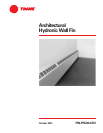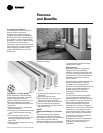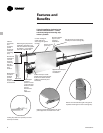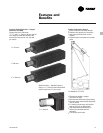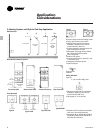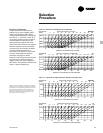
© 2001 American Standard Inc. All rights reserved.
FIN-PRC004-EN
A Complete Line of Wall Fin
Trane architectural wall fin is ideal for
heating modern commercial,
institutional or industrial buildings.
Attractive styling and wide application
flexibility allow wall fin cabinet designs
to be used for virtually any application.
Available for hydronic or steam heating,
Trane wall fin can also be used in
combination with convectors for smaller
areas, allowing for the use of one source
when designing a radiation heating
system. (See FIN-DS-2 for convector
applications.)
An effective heating system for any office. Attractive styling that blends with any
architectural design.
Trane Wall Fin — Simply the Best
Wall fin effectively meets the heating
needs of long, open areas. It counters
cold air downdrafts common to
expansive glass areas used in many of
today’s most prestigious buildings.
•
Provides continuous heat along room
perimeter.
•
Allows removal of any unit panel for
service accessibility.
•
The front panel never touches the wall
— only Trane’s exclusive mounting
strip.
•
The front panel can be raised or
removed without disturbing the unit or
damaging wallpaper, paint or the
plaster seal.
•
Operates quietly because there are no
moving parts.
•
Controls with the damper or valve
individually.
•
Blends well with any decor.
•
Works effectively with cooling-only
VAV and heat recovery systems.
•
Includes 14 or 16-gauge front panels.
•
Unit vent draft barrier enclosures.
•
Pipe enclosures for use with ForceFlo
and Fan Coil Units.
Wall Fin
I=B=R Certified Ratings for Trane Wall
Fin
The I=B=R symbol is the registered
trademark of the Hydronics Institute
which tests and rates in strict accordance
with published standard wall fin
elements and elements with enclosures.
The wall fin heating units must conform
to appropriate test standards to have
certified I=B=R ratings.
Why Hydronics?
Besides the reliability of equipment
ratings, and the well established
reliability of hydronic accessories, there
are many good reasons why hydronic
systems have long been recognized as
the standard method for providing
indoor comfort.
Hydronic heating, whether steam or hot
water, provides positive, controlled
circulation of the heating medium.
Systems are basically self-balancing, and
in larger, more complicated heating
systems, balancing is positively
controlled by familiar valves and
thermostats.
The life of some hydronic equipment
may be measured in decades; some
existing boilers are more than fifty years
old. In addition to the high efficiency of
boilers (some over 85%) the losses
through the distribution system are
extremely low on modern installations.
Temperature control is close to ideal with
hydronics. Any well-designed system
can provide excellent comfort, without
drafts or sharp swings in temperature.
The flexibility of hydronic installations
permits a variety of piping
arrangements, simple or sophisticated
controls, and a large choice of room
distribution units for all comfort
applications.
Type T
Type TA
Type F
Type S
Features
and Benefits



